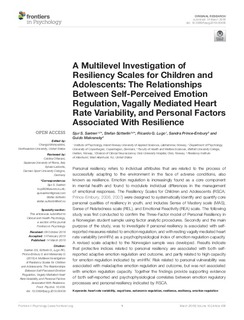A Multilevel Investigation of Resiliency Scales for Children and Adolescents: The Relationships Between Self-Perceived Emotion Regulation, Vagally Mediated Heart Rate Variability, and Personal Factors Associated with Resilience
Journal article, Peer reviewed
Published version

View/
Date
2019Metadata
Show full item recordCollections
Original version
10.3389/fpsyg.2019.00438Abstract
Personal resiliency refers to individual attributes that are related to the process of successfully adapting to the environment in the face of adverse conditions, also known as resilience. Emotion regulation is increasingly found as a core component in mental health and found to modulate individual differences in the management of emotional responses. The Resiliency Scales for Children and Adolescents (RSCA; Prince-Embury, 2006, 2007) were designed to systematically identify and quantify core personal qualities of resiliency in youth, and includes Sense of Mastery scale (MAS), Sense of Relatedness scale (REL), and Emotional Reactivity (REA) scale. The following study was first conducted to confirm the Three-Factor model of Personal Resiliency in a Norwegian student sample using factor analytic procedures. Secondly and the main purpose of the study, was to investigate if personal resiliency is associated with self-reported measures related to emotion regulation, and with resting vagally mediated heart rate variability (vmHRV) as a psychophysiological index of emotion regulation capacity. A revised scale adapted to the Norwegian sample was developed. Results indicate that protective indices related to personal resiliency are associated with both self-reported adaptive emotion regulation and outcome, and partly related to high capacity for emotion regulation indicated by vmHRV. Risk related to personal vulnerability was associated with maladaptive emotion regulation and outcome, but was not associated with emotion regulation capacity. Together the findings provide supporting evidence of both self-reported and psychophysiological correlates between emotion regulatory processes and personal resiliency indicated by RSCA.
